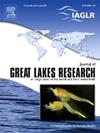合成微纤维在劳伦森五大湖的底栖藻类中无处不在
IF 2.5
3区 环境科学与生态学
Q3 ENVIRONMENTAL SCIENCES
引用次数: 0
摘要
合成微纤维是一类微塑料,通常从家庭洗衣和污水处理厂排放到环境介质中。人口密度高的地区排放了大量的合成微纤维,这些微纤维污染并积聚在沉积物、地表水、藻类和生态系统的其他部分。合成微纤维在北美的劳伦森五大湖中非常丰富,但它们的运动和命运却没有得到很好的理解。巨藻能有效地隔离微纤维;然而,目前尚不清楚五大湖底栖藻类中合成微纤维的数量是否因人口密度或藻类类型(如Cladophora或charophytes)而异。这里展示的是一项为期4年的研究,该研究调查了劳伦森五大湖中的四个底栖藻类样本:密歇根湖、休伦湖、安大略湖和伊利湖。从藻类样品中分离和定量合成微纤维,并分析其与藻类类型、湖泊和种群密度的关系。各湖泊底栖藻类每公斤(干重)合成微纤维的平均估计数在1.6 × 104 ~ 2.0 × 104之间。显微分析表明附生硅藻和底栖巨藻(Cladophora)之间可能存在相互作用,这可能有助于解释无论藻类类型如何,藻类都具有隔离微纤维的能力。研究结果还表明,人口密度与底栖藻类中合成微纤维的数量之间缺乏相关性,这可能意味着微纤维在大型水体(包括大型无脊椎动物和鱼类群落的水生食物网)中易于移动和分布。本文章由计算机程序翻译,如有差异,请以英文原文为准。
Synthetic microfibers are ubiquitous in benthic algae from the Laurentian Great Lakes
Synthetic microfibers are a class of microplastics routinely released into environmental media from domestic laundry and wastewater treatment plant effluent. Areas of high human population density discharge immense amounts of synthetic microfibers that pollute and accumulate in sediments, surface waters, algae, and other parts of the ecosystem. Synthetic microfibers are abundant in the Laurentian Great Lakes of North America, but their movement and fate are not well understood. Macroalgae effectively sequester microfibers; however, it is unknown if quantities of synthetic microfibers differ in benthic algae of the Great Lakes based on human population density or algal type (such as Cladophora or charophytes). Presented here is a 4-year study that investigated benthic algae samples from four of the Laurentian Great Lakes: Lakes Michigan, Huron, Ontario, and Erie. Synthetic microfibers were isolated and quantified in the algal samples, and values were analyzed with respect to algal type, lake, and population density. The average estimated number of synthetic microfibers per kg (dry weight) of benthic algae in each lake ranged from 1.6 104 to 2.0 104. Microscopic analysis suggested a possible interaction between epiphytic diatoms and benthic macroalgae (Cladophora), which may help to explain the ability of the algae to sequester microfibers regardless of algal type. The results also suggest a lack of correlation between human population density and number of synthetic microfibers in benthic algae, which could imply facile movement and distribution of microfibers in large bodies of water, that includes the aquatic food web of macroinvertebrates and fish communities.
求助全文
通过发布文献求助,成功后即可免费获取论文全文。
去求助
来源期刊

Journal of Great Lakes Research
生物-海洋与淡水生物学
CiteScore
5.10
自引率
13.60%
发文量
178
审稿时长
6 months
期刊介绍:
Published six times per year, the Journal of Great Lakes Research is multidisciplinary in its coverage, publishing manuscripts on a wide range of theoretical and applied topics in the natural science fields of biology, chemistry, physics, geology, as well as social sciences of the large lakes of the world and their watersheds. Large lakes generally are considered as those lakes which have a mean surface area of >500 km2 (see Herdendorf, C.E. 1982. Large lakes of the world. J. Great Lakes Res. 8:379-412, for examples), although smaller lakes may be considered, especially if they are very deep. We also welcome contributions on saline lakes and research on estuarine waters where the results have application to large lakes.
 求助内容:
求助内容: 应助结果提醒方式:
应助结果提醒方式:


